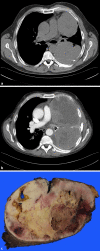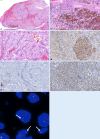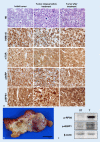Complexity of PEComas : Diagnostic approach, molecular background, clinical management
- PMID: 31309284
- PMCID: PMC7286949
- DOI: 10.1007/s00292-019-0612-5
Complexity of PEComas : Diagnostic approach, molecular background, clinical management
Abstract
Perivascular epithelioid cell neoplasms (PEComas) are a family of mesenchymal neoplasms with features of both melanotic and smooth muscle differentiation. PEComa morphology is highly variable and encompasses epithelioid to spindle cells often with clear cytoplasm and prominent nucleoli. Molecularly, most PEComas are defined by a loss of function of the TSC1/TSC2 complex. Additionally, a distinct small subset of PEComas harboring rearrangements of the TFE3 (Xp11) gene locus has been identified. By presenting a series of three case reports with distinct features, we demonstrate diagnostic pitfalls as well as the importance of molecular work-up of PEComas because of important therapeutic consequences.
Perivaskuläre epitheloidzellige Tumoren (PECome) gehören zu einer Familie von mesenchymalen Neoplasien mit Merkmalen der melanotischen und glattmuskulären Differenzierung. Die Morphologie der PECome ist sehr variabel und umfasst epitheloide und spindelige Zellen, oft mit klarem Zytoplasma und prominenten Nukleoli. Molekular sind die meisten PECome durch einen Funktionsverlust des TSC1-TSC2-Komplexes definiert. Zusätzlich wurde eine kleine Untergruppe von PEComen identifiziert, die Rearrangements des TFE3(Xp11)-Genlocus aufzeigen. Anhand von 3 Fallberichten sollen die diagnostischen Fallstricke und die Bedeutung der molekularen Charakterisierung von PEComen auch wegen der therapeutischen Konsequenzen näher dargestellt werden.
Keywords: Genetic translocation; Immunohistochemistry; Lymphangioleiomyomatosis; Perivascular epithelioid cell neoplasms; TOR serine-threonine kinases.
Conflict of interest statement
K. Utpatel, D.F. Calvisi, G. Köhler, T. Kühnel, A. Niesel, N. Verloh, M. Vogelhuber, R. Neu, N. Hosten, H.-U. Schildhaus, W. Dietmaier, and M. Evert declare that they have no competing interests.
Figures






References
-
- Au KS, Williams AT, Roach ES, et al. Genotype/phenotype correlation in 325 individuals referred for a diagnosis of tuberous sclerosis complex in the United States. Genet Med Off J Am Coll Med Genet. 2007;9:88–100. - PubMed
Publication types
MeSH terms
LinkOut - more resources
Full Text Sources

